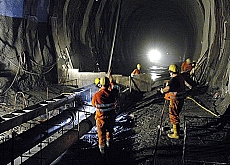Lötschberg tunnel makes rail history

The piercing of the Lötschberg tunnel through the Alps can be considered yet another engineering marvel of the Swiss transport network.
It was only in December that the backbone of the future rail network – a high-speed connection between Rothrist and Mattstetten – was opened with much ceremony.
Workers broke through the new base tunnel, which links the cantons of Bern and Valais, on Thursday.
The tunnel – 34.6 kilometres long – will, when finished in 2007, shave travel time between Bern and Brig in canton Valais by a third. It will also shorten the journey between Germany and Milan by an hour.
The Lötschberg line is the first of two main rail arteries aimed at moving transalpine transit traffic from road to rail. The policy was approved by Swiss voters in 1998.
No doubt in a few years’ time, the Gotthard base tunnel – which will be the longest rail tunnel in the world – will steal the headlines from the Lötschberg. But today, it is the construction workers and engineers of the Lötschberg who deserve their moment in the spotlight.
The aim was to spend SFr31.6 billion ($26.5 billion) on two new base tunnels at both the Lötschberg and the Gotthard in a project called New Rail Links through the Alps (NRLA).
The former finance minister, Otto Stich, from the centre-left Social Democrats, made no secret of the fact he was against the project because he believed it would never be profitable.
But the rightwing Swiss People’s Party transport minister of the day, Adolf Ogi, was an enthusiastic supporter and still is.
Soaring costs
Costs have, not surprisingly, gone up since then – 31 per cent at the Lötschberg alone – and the NRLA issue in parliament allows some politicians to vent their wrath at soaring budgets. But now most people seem to agree that the tunnels were money well spent.
The cause of all the fuss about transport policy in Switzerland was the opening of the Gotthard road tunnel in 1980, which radically changed thinking not only about transport but also the environment.
Most trucks travelling in Switzerland today are in transit. In 1981 this share made up a quarter of heavy goods traffic. Since then this has risen to about three quarters, resulting in noise and air pollution on the feeder roads in the Alpine valleys to the north and south of the Gotthard being over the legal limits.
This was a strong argument in favour of shifting transit traffic from road to rail. But exactly what will the new Lötschberg tunnel route contribute to ease this situation?
It will constitute the first high-speed north-south rail link through the Alps and for several years it will be the only such link.
Increased demand
Not only will it meet increased demands for goods transport with greater capacity, but it will also allow faster connections for passenger transport.
The link with the European high-speed rail network and speeds of up to 250 kilometres per hour through the tunnel will mean faster connections for travellers and commuters.
Railway purists may scorn at praise for a tunnel that sacrifices beautiful scenery for shorter travelling times and they do have a point.
Why come to Switzerland to travel though darkness when you can experience the skills of engineers who pioneered Swiss railways a century ago?
The ride from Frutigen in the Bernese Oberland up the north ramp to Kandersteg through the present Lötschberg tunnel to Goppenstein and down the south ramp to Brig is stunning… and it will remain open, so there is no cause for concern.
The old school
Many have waxed lyrical about that particular stretch of Switzerland’s railway network.
One great admirer of Swiss railway engineering, Cecil J. Allen, wrote that in passing through the Lötschberg tunnel from north to south “we have made our way from the watershed of the Rhine to that of the Rhone”.
“Water that we saw flowing past us before entering the Lötschberg tunnel was on its way to the North Sea; that which now comes into view, in the Lonza gorge, will flow into the Rhone and be carried by that river into the Mediterranean.”
Even with the new base tunnels, the old tracks will remain and visitors to Switzerland can take their pick.
swissinfo, Robert Brookes
Length of Lötschberg base tunnel – 34.6 kilometres.
Separation between the tubes – 40 metres.
Elevation at the Frutigen north portal – 776.5m above sea level.
Elevation at the Raron south portal – 654.2m above sea level.
Length of track system – 57 km.
The Lötschberg base tunnel (34.6 km) runs from Frutigen in the Kander valley to Raron in canton Valais.
It is designed as a system with two separate one-way single-track tubes. But in a first phase only one tunnel will be constructed between the north portal in Frutigen and the projected service station in Mittelholz.
For safety reasons, the tunnels are connected by transverse tunnels every 333m.
The first passenger trains are expected to run through the tunnel in December 2007.

In compliance with the JTI standards
More: SWI swissinfo.ch certified by the Journalism Trust Initiative











You can find an overview of ongoing debates with our journalists here . Please join us!
If you want to start a conversation about a topic raised in this article or want to report factual errors, email us at english@swissinfo.ch.